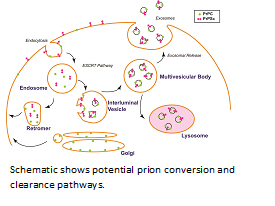How do prion aggregates spread from cell-to-cell through the brain, and how does the quaternary structure impact the capacity of a prion to spread?
Prions are aggregated proteins that template the misfolding of the cognate cellular monomer, a process shared by other amyloidogenic proteins. Unlike the monomer, the aggregate is highly stable and poses challenges for cells to degrade. To clear prions, cells may degrade prions intracellularly through autophagy or release prions in exosomes or through unconventional secretion, contributing to further prion spread through the central nervous system.
A key research interest is to understand how the structure of a protein aggregate drives its intra- and extracellular transit pathways and aggregate clearance mechanisms. Prions assemble into distinct structures that correlate to remarkably different clinical consequences for the patient, for example, disease progression (rapid or slow) and disease symptoms. We use prion strains that form large fibrillar plaques or small subfibrillar structures to probe how prion structure impacts cell entry and exit routes and spread through the brain.
In recent years, we have found that certain fibril-forming prion strains are not capable of entering the brain, but replicate persistently in the spleen. Current studies are underway to uncover the underlying mechanisms and structural properties that influence prion dissemination through the central nervous system. By focusing on how prions traffic, we aim to reveal fundamental insights on the cellular degradation pathways and uncover new therapeutic avenues for prion and other neurodegenerative diseases.


Brain immunolabelled for PrP shows diffuse prion aggregates or large dense plaques in mice exposed to highly or poorly neuroinvasive prion strains
